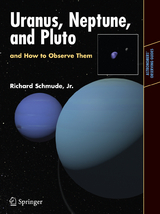Uranus, Neptune, and Pluto and How to Observe Them
Seiten
2008
Springer-Verlag New York Inc.
978-0-387-76601-0 (ISBN)
Springer-Verlag New York Inc.
978-0-387-76601-0 (ISBN)
This fascinating volume is unique in that it gives a completely up-to-date summary of our current knowledge of the remote planets, and also explains how amateur astronomers can contribute to our knowledge of the remote planets.
This book is for two groups of people: those who want to study the remote planets with amateur astronomical equipment, and those who are just interested in learning about our knowledge of the remote planets.
The Remote Planets, and How to Observe them is unique in that it gives a completely up-to-date summary of our current knowledge of the remote planets, and also explains how amateur astronomers can contribute to our knowledge of the remote planets. Readers are given some inspiring examples of people who, with modest commercially-made equipment, have made important contributions to our scientific knowledge.
The observational section goes into great detail, including optical and CCD photometry, occultation measurements, imaging (including stacking and enhancement techniques) and polarization measurements.
There are finder charts (from 2010 to 2026), complete with two sets of star-magnitudes in an appendix (one set of magnitudes are for photoelectric photometry and the other set is for visual photometry)
This book is for two groups of people: those who want to study the remote planets with amateur astronomical equipment, and those who are just interested in learning about our knowledge of the remote planets.
The Remote Planets, and How to Observe them is unique in that it gives a completely up-to-date summary of our current knowledge of the remote planets, and also explains how amateur astronomers can contribute to our knowledge of the remote planets. Readers are given some inspiring examples of people who, with modest commercially-made equipment, have made important contributions to our scientific knowledge.
The observational section goes into great detail, including optical and CCD photometry, occultation measurements, imaging (including stacking and enhancement techniques) and polarization measurements.
There are finder charts (from 2010 to 2026), complete with two sets of star-magnitudes in an appendix (one set of magnitudes are for photoelectric photometry and the other set is for visual photometry)
Richard Schmude Jr. has a Ph D in Physical Chemistry, and has taught solar system astronomy for over 10 years. He has been Remote Planets Coordinator for the Association of Lunar and Planetary Observers (ALPO) since 1990, and has written 18 scientific papers about the remote planets in various journals. He has a total of 103 published papers. He has been a full-time college Professor at Gordon College since 1994.
The Uranus System.- The Neptune System.- Pluto and Its Moons.- Observing Uranus and Neptune with Binoculars and Small Telescopes.- Observing with Medium-Sized Telescopes.- Observing with Large Telescopes.
| Reihe/Serie | Astronomers' Observing Guides |
|---|---|
| Zusatzinfo | XI, 232 p. |
| Verlagsort | New York, NY |
| Sprache | englisch |
| Maße | 178 x 235 mm |
| Themenwelt | Sachbuch/Ratgeber ► Natur / Technik ► Weltraum / Astronomie |
| Naturwissenschaften ► Physik / Astronomie ► Astronomie / Astrophysik | |
| ISBN-10 | 0-387-76601-4 / 0387766014 |
| ISBN-13 | 978-0-387-76601-0 / 9780387766010 |
| Zustand | Neuware |
| Haben Sie eine Frage zum Produkt? |
Mehr entdecken
aus dem Bereich
aus dem Bereich
Perspektiven auf die Menschheit
Buch | Hardcover (2024)
Klett-Cotta (Verlag)
CHF 34,95
auf der Suche nach neuen Planeten und außerirdischem Leben
Buch | Hardcover (2024)
Droemer (Verlag)
CHF 33,55




